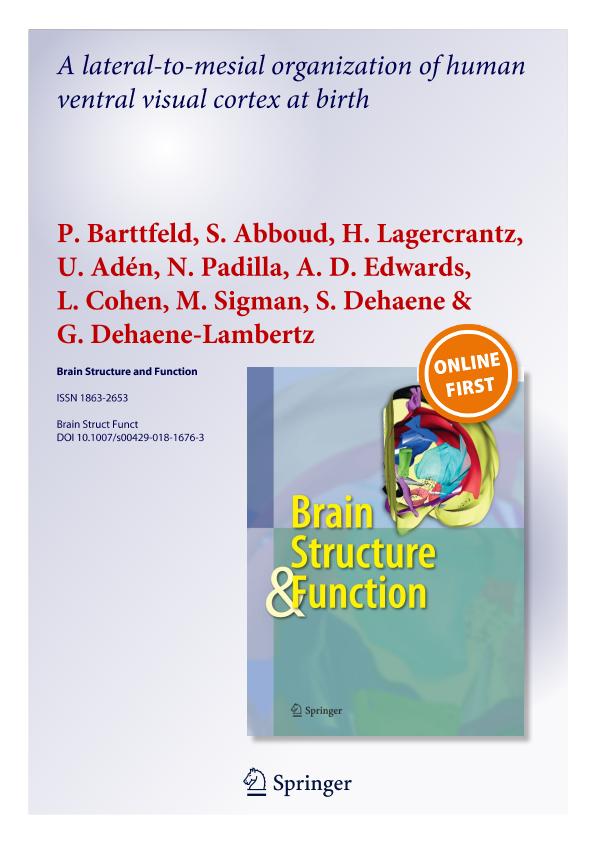Artículo
A lateral-to-mesial organization of human ventral visual cortex at birth
Barttfeld, Pablo ; Abboud, S.; Lagercrantz, H.; Adén, U.; Padilla, N.; Edwards, A. D.; Cohen, L.; Sigman, Mariano
; Abboud, S.; Lagercrantz, H.; Adén, U.; Padilla, N.; Edwards, A. D.; Cohen, L.; Sigman, Mariano ; Dehaene, Stanislas; Dehaene Lambertz, G.
; Dehaene, Stanislas; Dehaene Lambertz, G.
 ; Abboud, S.; Lagercrantz, H.; Adén, U.; Padilla, N.; Edwards, A. D.; Cohen, L.; Sigman, Mariano
; Abboud, S.; Lagercrantz, H.; Adén, U.; Padilla, N.; Edwards, A. D.; Cohen, L.; Sigman, Mariano ; Dehaene, Stanislas; Dehaene Lambertz, G.
; Dehaene, Stanislas; Dehaene Lambertz, G.
Fecha de publicación:
09/2018
Editorial:
Springer Heidelberg
Revista:
Brain Structure & Function
ISSN:
1863-2653
e-ISSN:
1863-2661
Idioma:
Inglés
Tipo de recurso:
Artículo publicado
Clasificación temática:
Resumen
In human adults, ventral extra-striate visual cortex contains a mosaic of functionally specialized areas, some responding preferentially to natural visual categories such as faces (fusiform face area) or places (parahippocampal place area) and others to cultural inventions such as written words and numbers (visual word form and number form areas). It has been hypothesized that this mosaic arises from innate biases in cortico-cortical connectivity. We tested this hypothesis by examining functional resting-state correlation at birth using fMRI data from full-term human newborns. The results revealed that ventral visual regions are functionally connected with their contra-lateral homologous regions and also exhibit distinct patterns of long-distance functional correlation with anterior associative regions. A mesial-to-lateral organization was observed, with the signal of the more lateral regions, including the sites of visual word and number form areas, exhibiting higher correlations with voxels of the prefrontal, inferior parietal and temporal cortices, including language areas. Finally, we observed hemispheric asymmetries in the functional correlation of key areas of the language network that may influence later adult hemispheric lateralization. We suggest that long-distance circuits present at birth constrain the subsequent functional differentiation of the ventral visual cortex.
Palabras clave:
BRAIN
,
FUNCTIONAL CONNECTIVITY
,
LANGUAGE
,
NEONATES
Archivos asociados
Licencia
Identificadores
Colecciones
Articulos(SEDE CENTRAL)
Articulos de SEDE CENTRAL
Articulos de SEDE CENTRAL
Citación
Barttfeld, Pablo; Abboud, S.; Lagercrantz, H.; Adén, U.; Padilla, N.; et al.; A lateral-to-mesial organization of human ventral visual cortex at birth; Springer Heidelberg; Brain Structure & Function; 223; 7; 9-2018; 3107-3119
Compartir
Altmétricas



